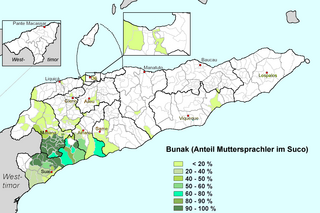Related Research Articles
Kobon is a language of Papua New Guinea. It has somewhere around 90–120 verbs.
The Kol language is a language spoken in eastern New Britain island, Papua New Guinea. There are about 4000 speakers in Pomio District of East New Britain Province, mostly on the southern side of New Britain island.

The Bunak language is the language of the Bunak people of the mountainous region of central Timor, split between the political boundary between West Timor, Indonesia, particularly in Lamaknen District and East Timor. It is one of the few on Timor which is not an Austronesian language, but rather a Papuan language of the Timor–Alor–Pantar language family. The language is surrounded by Malayo-Polynesian languages, like Uab Meto and Tetum.

Huli is a Tari language spoken by the Huli people of the Hela Province of Papua New Guinea. It has a pentadecimal (base-15) numeral system: ngui means 15, ngui ki means 15×2 = 30, and ngui ngui means 15×15 = 225.
Kairiru is one of three Kairiru languages spoken mainly on Kairiru and Mushu islands and in several coastal villages on the mainland between Cape Karawop and Cape Samein near Wewak in East Sepik Province of Papua New Guinea.
Boiken is one of the more populous of the Ndu languages of Sepik River region of northern Papua New Guinea. It is spoken around Boiken Creek in Yangoru-Saussia District, East Sepik Province and adjacent islands off the north coast of northern Papua New Guinea.
Mongol, also known as Mwakai, is a Keram language of Papua New Guinea. Despite the name, it is not related to Mongolian, which is spoken in East Asia.
The Suabo or Inanwatan is a Papuan language of Southwest Papua. It is often classified in the South Bird's Head language family, but may alternatively form an independent language family together with Duriankere.
Grand Valley Dani, or simply Dani, is one of the most populous Papuan languages in Indonesian New Guinea. The Dani people live in the Baliem Valley of the Western Highlands.
Qaqet, or Baining, is a non-Austronesian language from the Baining family spoken in East New Britain Province on the island of New Britain, Papua New Guinea.
Kovai is a Papuan language spoken on Umboi Island, halfway between mainland Papua New Guinea and the island of New Britain, and mostly within the caldera of that volcanic island.
Orokaiva is a Papuan language spoken in the "tail" of Papua New Guinea.
Shiaxa (Sjiagha) and Yenimu, together known as South Awyu, are a Papuan language or languages of Papua, Indonesia. Whether they constitute one language or two depends on one's criteria for a 'language'. The two varieties are,
Awa is a Kainantu language of Papua New Guinea.
Wano is a Papuan language spoken by the Wano people in Puncak and Puncak Jaya regencies of the Indonesian province of Central Papua.
Mato is a minor Austronesian language of northern Papua New Guinea just inside Morobe Province. Mato is also referred to by the names Nenaya, Nengaya, and Nineia. Mato language has two minor variations, Tabares and Remuk, and the two variations are each spoken in three separate villages. While Mato is surrounded by several other languages, this has no effect on the grammar changes within Mato boundaries. The linguistic situation is very stable, due in part to the geographical isolation of the Mato people.
Tungag, or Lavongai, is an Austronesian language of New Ireland Province, Papua New Guinea, localized New Hanover, the native name of which is Lavongai.
Iduna is an Austronesian language spoken on Goodenough Island of Milne Bay Province of Papua New Guinea.
This article covers the phonology of the Kerkrade dialect, a West Ripuarian language variety spoken in parts of the Kerkrade municipality in the Netherlands and Herzogenrath in Germany.
Manyjilyjarra is generally considered a dialect of the Western Desert language.
References
- ↑ Western Dani at Ethnologue (18th ed., 2015) (subscription required)
- ↑ Barclay, Peter (2008). A Grammar of Western Dani.